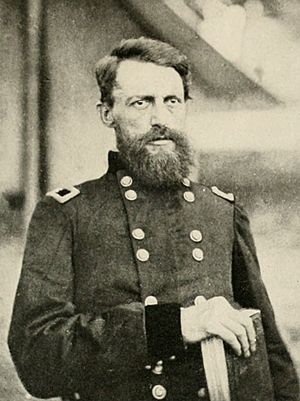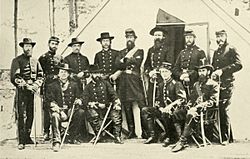George Stoneman facts for kids
Quick facts for kids
George Stoneman Jr.
|
|
|---|---|

George Stoneman during the American Civil War
|
|
| 15th Governor of California | |
| In office January 10, 1883 – January 8, 1887 |
|
| Lieutenant | John Daggett |
| Preceded by | George C. Perkins |
| Succeeded by | Washington Bartlett |
| Personal details | |
| Born | August 8, 1822 Busti, New York |
| Died | September 5, 1894 (aged 72) Buffalo, New York |
| Political party | Democratic |
| Spouse | Mary Stoneman |
| Children | 4 |
| Signature | |
| Military service | |
| Allegiance | United States of America Union |
| Branch/service | United States Army Union Army |
| Years of service | 1846–1871 |
| Rank | |
| Commands | III Corps Cavalry Corps XXIII Corps |
| Battles/wars | American Civil War |
George Stoneman Jr. (born August 8, 1822 – died September 5, 1894) was an important American soldier and politician. He was a United States Army cavalry officer. Cavalry means soldiers who fight on horseback. Later, he became the fifteenth Governor of California, serving from 1883 to 1887.
Stoneman went to the famous West Point military school. He graduated in 1846. He served in the Army for 36 years. During this time, he fought in several conflicts. These included the Mexican–American War, the Yuma War, and the American Civil War. In 1861, he became a Brigadier General. He later led important parts of the Union Army.
After the Civil War, Stoneman moved to California. He had a large estate there. He was elected governor and worked to control powerful railroads. He also tried to make prisons better.
Contents
Early Life and Military Training
Stoneman was born on a farm in Busti, New York. He was the first of ten children. His father, George Stoneman Sr., worked with lumber and was a local judge.
He went to Jamestown Academy. Then, in 1842, he entered the United States Military Academy. His roommate at West Point was Thomas J. "Stonewall" Jackson. Jackson later became a famous general for the Confederate side. Stoneman graduated in 1846.
After graduating, Stoneman became a second Lieutenant. He joined the Mormon Battalion. This group marched from Iowa to California for the Mexican–American War. By the time they arrived, the United States already controlled California. So, his unit did not fight in any battles. Stoneman helped with supplies for the march.
He later fought in the Yuma War. He also helped map the Sierra Nevada mountains for new railroad lines. In 1855, he became a captain. He mainly served in Texas until 1861.
Fighting in the Civil War
When the Civil War began, Stoneman was in charge of Fort Brown in Texas. He refused to surrender his fort to the Confederate forces. He managed to escape north with most of his soldiers.
He was then sent east. He became a major in May 1861. Stoneman worked as an assistant to General George B. McClellan in Western Virginia. When McClellan took command of the main Union army, the Army of the Potomac, he made Stoneman his chief of cavalry. Stoneman was promoted to brigadier general in August. He and McClellan sometimes disagreed on how to best use cavalry.
On November 22, 1861, Stoneman married Mary Oliver Hardisty. They had four children together.
After some military setbacks, Stoneman was moved to lead infantry soldiers. He took command of the 1st Division of the III Corps in September 1862. This was after its previous commander was killed. His corps stayed in Washington, D.C. during the Maryland campaign. In October, Stoneman took command of the entire III Corps.
At the Battle of Fredericksburg, his corps helped push back a Confederate attack. After this battle, Joseph Hooker became the new commander of the Army of the Potomac. Hooker decided to combine all the cavalry units into one large corps. He put Stoneman in charge of this new cavalry corps.
Stoneman's Cavalry Raids
For the Battle of Chancellorsville, General Hooker gave Stoneman a very important job. Stoneman's Cavalry Corps was supposed to ride deep behind Robert E. Lee's army. Their goal was to destroy railroads and supplies. This would distract Lee from Hooker's main attack.
However, Stoneman's raid did not go as planned. His cavalry started well in May 1863. But they soon got stuck after crossing the Rapidan River. During the entire battle, Stoneman achieved very little. Hooker blamed Stoneman for the Union defeat at Chancellorsville. Stoneman was removed from his cavalry command. He was sent to Washington, D.C., to work at a desk job. A large cavalry supply base was even named Camp Stoneman in his honor.
In early 1864, Stoneman wanted to return to field command. He got a new role leading the Cavalry Corps of the Army of the Ohio. This army was fighting in the Atlanta Campaign under General William Tecumseh Sherman. Stoneman led a raid to try and free prisoners from the famous Andersonville Prison. During this raid, he and his assistant were captured by Confederates near Macon, Georgia. He became the highest-ranking Union officer captured during the war. He was a prisoner for three months.
General Sherman quickly arranged for Stoneman to be exchanged. After his release, Stoneman briefly commanded the Department of the Ohio. In December 1864, he led a raid through southwestern Virginia. In March 1865, Stoneman led about 4,000 troops from Knoxville, Tennessee. They raided Virginia and North Carolina. Their goal was to damage Confederate supplies and lower morale. Within a week, they attacked towns like Hillsville and Asheville. They also destroyed bridges, lead mines, and railroads.
Life After the War
In June 1865, after the war ended, Stoneman commanded troops in Memphis, Tennessee. He was criticized for not acting quickly enough during the Memphis riots of 1866. These riots caused a lot of damage. Stoneman was investigated by Congress but was found innocent.
Stoneman was then assigned to help govern the military in Petersburg, Virginia. In 1868, he took command of the First Military District. Stoneman was a Democrat. He disagreed with the strict rules of Reconstruction, the period after the war. He chose more moderate policies. This made him popular among white Virginians.
Stoneman left volunteer service in September 1866. He returned to his regular army rank of colonel. In 1869, the Army sent him west. He commanded military districts in Arizona. However, he was removed from command in 1871. This was due to disagreements about how he handled relations with Native American groups. On August 16, 1871, Stoneman retired from the army due to a disability.
Governor of California
Stoneman moved to California. He had always wanted to live there since his early military service. He and his wife settled in the San Gabriel Valley. They had a 400-acre estate called Los Robles. This place is now a California Historical Landmark.
In 1876, he was appointed to the California Transportation Commission. In 1879, he was elected as a California Railroad Commissioner.
In 1882, Stoneman was elected governor of California as a Democrat. He served one four-year term. As governor, he wanted to control the prices and power of the Southern Pacific Railroad. However, he was not successful. The state legislature was largely controlled by the railroad.
Stoneman also believed in making prisons better. He thought prisoners could improve and be released early. He granted many pardons and reduced many prison sentences during his last weeks in office. Stoneman was not chosen to run for governor again in 1886. He left public service after his term ended.
He returned to New York for medical care. He stayed with his sister. Stoneman had a stroke in April 1894 and could not recover. He died in Buffalo, New York, on September 5, 1894, at age 72. He was buried at Bentley Cemetery in Lakewood, New York.
Legacy and Honors
Stoneman's raids in North Carolina and Virginia near the end of the war were remembered in a song. The songwriter Robbie Robertson of The Band wrote "The Night They Drove Old Dixie Down" in 1969.
The singer Joan Baez recorded the song in 1971. In her version, she sang "so much cavalry" instead of "Stoneman's cavalry." She later said she learned the song by listening to it and misheard the words.
Several places are named in Stoneman's honor:
- Stoneman Avenue in Alhambra, California.
- Camp Stoneman, near Pittsburg, California. This was a place where many soldiers left for war in World War II and the Korean War.
- Stoneman Elementary School in San Marino, California. It is built on his old ranch property.
- In 1885, a luxury hotel in Yosemite National Park was named Stoneman House. The nearby Stoneman Meadow and Stoneman Bridge are also named after the hotel.
- Stoneman Lake in Arizona.
- General George Stoneman Business Park in Busti, New York, is on his family's old farm.
His name is also on the Star of Honor at the Sonoma Veterans Memorial Park. This is because he spent time there before the Civil War.
See also
 In Spanish: George Stoneman para niños
In Spanish: George Stoneman para niños
- List of American Civil War generals (Union)




